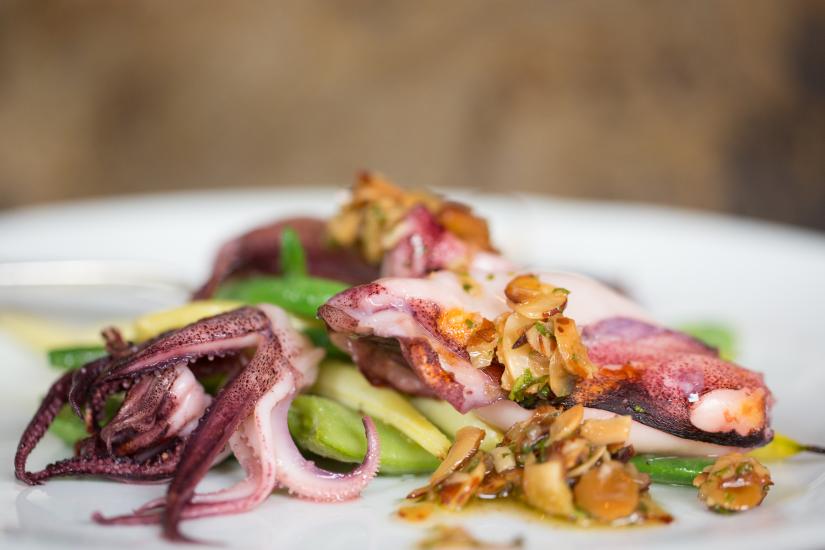Market Squid
Doryteuthis opalescens
The Science
THE SCIENCE
The egg cases released by the female are made up of several layers of protein between which bacteria grow and serve as protection against fungal infection.
Taxonomic description
- Small open ocean mollusk possessing eight arms and two longer tentacles used for mating and prey capture. [1]
- Mix of iridescent white and purple, but can change colors in response to the environment. [1]
- Swims backwards through the water, propelled by valves near the head. [1]
- Produces “ink,” a dark pigment released into the water to divert the attention of predators. [2]
- Reaches lengths of 30cm (12in). [2]
Distribution
- Ranges from southeastern Alaska to Bahia Asunción in Baja California, Mexico. [2]
- Most abundant through Punta Eugenia in Baja California, and Monterey Bay, California. [1]
Life history
- After mating, females release egg cases which are attached to the seafloor.
- Each case contains 200 to 300 eggs. [2]
- Larval squid hatch after 3-5 weeks. [2]
- Spawning occurs April – November in Northern California, and October – May in Southern California. [3]
- Reaches maturity six months after hatching. [4]
- Has a short life span, living an average of 188 days, 300 at most, and dying shortly after spawning. [4]
Habitat
- Found offshore, except during spawning which occurs in the near shore coastal waters. [2]
- Can be found in the water column from the surface to 792m (2,600ft) depths. [1]
- Is migratory, and forms massive schools. [1]
- Feeds on small crustaceans, fish and other squid. [2]
- Prey for marine mammals and large pelagic fish. [2]
The Fishery
THE FISHERY
Southern California, mainly around the Channel Islands, comprises 90% of squid landings!
Seasonal availability
- Available in San Diego from Sept-March. [5]
Regulatory and managing authority
- Managed federally by the NOAA fisheries and, as established by the Magnuson-Stevens Act, the Pacific Fishery Management Council (PFMC) through the Coastal Pelagic Species Fishery Management Plan (CPSFMP). [8]
- As established by the Marine Life Management Act, the California Fish and Game Commission (CFGC) regulates the fishery in state waters, and the California Department of Fish and Wildlife (CDFW) collects data and helps enforce FMP management rules for this fishery through the Pelagic Fisheries and Ecosystems Program. [5,8]
- The California Wetfish Producers Association combines input from the industry and government entities to inform regulatory and management measures for this fishery. [9]
Status of the fishery
- Sensitive to water temperatures – catch decreases with warming in El Niño years, increases with cooler waters of La Niña. [6]
- Was the largest California commercial fishery by volume in 1993 with 47,100 tons landed. [3]
- Became most valuable California fishery resource by 1996 at $33.3 million. [3]
- Demand for squid is largely dictated by overseas markets.
- The entire stock replaces itself semi-annually even in the absence of fishing, and is able to recover from drastic decreases in the population. [3]
Gear type
- Purse seine nets are laid out by seiner vessels to encircle and haul spawning schools.
- Brail vessels use hydraulic dip nets.
- Use of lights to attract squid to the surface is legal throughout California
Potential ecosystem impacts
- Attractant lights can disturb nesting seabirds; to circumvent this, wattage is limited and lights are shielded. [1]
- Haul chains and bottoms of purse-seines can scrape and drag against the seafloor, damaging the benthic ecosystem. [5,6]
- Bycatch is minimal, and is mostly composed of sardine, anchovy, or mackerel, but can occasionally include squid egg cases from the seafloor if nets are drawn in shallower waters. [1,6]
- The observed decrease in average length and weight of market squid (1999-2007) could affect population resilience as female fecundity increases with size. [3]
The Seafood
THE SEAFOOD
If overcooked, market squid has been said to taste "like a rubber band." If cooked properly, the meat is nutty, sweet, and delicate.


Edible portions
- The arms (tentacles), mantle (tube), and fins (wings) are all edible. [1]
Description of meat
- Raw squid should be moist, shiny, and ivory colored. [1]
- Once cooked, the meat turns white and has a mild, slightly sweet taste. [1]
Culinary uses
- Can be thawed and then refrozen without damaging the meat. [7]
- Clean as much as possible before cooking, making sure to remove the cartilage inside the mantle.
- Gently rubbing the body of the squid with your thumbs will remove the thin layer of skin. [7]
- Common recipes feature the squid in pasta dishes, soups and stews.
- For a Lebanese-style calamari recipe, visit Eat Smarter. [10]
- For an Indonesian squid curry recipe, visit Selly's Corner. [11]
Nutritional information
- Information about 100g of raw squid are on the table on the right. [1]
Toxicity report
- No known toxins. [1]
Seasonal availability
- Available Sept — March, unless the catch limit is reached before end of the season. [1]
References
[1] NOAA FishWatch. Fish Watch and Seafood Profiles. California Market Squid. Web. https://www.fishwatch.gov/profiles/california-market-squid. Accessed 2 September 2020.
[2] Recksiek, C.W., H. W. Frey. Biological, Oceanographic, and Acoustic Aspects of the Market Squid, Loligo Opalescens Berry. Fish Bulletin 169. https://escholarship.org/uc/item/1dz5j9cf
[3] Leet, W.S. California Market Squid. 2001. California's Living Marine Resources: A Status Report. Sacramento: California Dept. of Fish and Game. 295-298. https://nrm.dfg.ca.gov/FileHandler.ashx?DocumentID=34420
[4] Butler, et al.1999. Age and Growth of Market Squid Off California. CalCOFl Rep.: 40. http://calcofi.org/publications/calcofireports/v40/Vol_40_Butler_etal.p…
[5] Overview of the Pelagic Fisheries and Ecosystems Program. California Dept. of Fish and Wildlife. n.d. https://wildlife.ca.gov/Conservation/Marine/Pelagic/Market-Squid. Accessed 9 December 2020.
[6] Voices of the Bay: Fishery Basics - California Fisheries. Market Squid (Doryteuthis opalescens). 2011. http://sanctuaries.noaa.gov/education/voicesofthebay/pdfs/marketsquid.p…
[7] Tin, K. Cooking: How to clean and prepare raw squid for cooking.” 25 Oct 2010. Web. www.youtube.com/watch?v=1fdPl777Ji0.
[8] California Department of Fish and Wildlife. 2019 Market Squid, Doryteuthis (Loligo) opalescens, Enhanced Status Report. Web. https://marinespecies.wildlife.ca.gov/market-squid/. Accessed 2 December 2020.
[9] California Wetfish Producers Association. 2013. California Wetfish Producers Association. Web. https://californiawetfish.org/. Accessed 2 December 2020.
[10] Eat Smarter! n.d. Lebanese-Style Calamari with Homemade Harissa. Web. https://eatsmarter.com/recipes/lebanese-style-calamari. Accessed 15 January 2021.
[11] Selly's Corner. n.d. Cumi Gulai Padang (Padangnese Squid Curry). Web. https://sellyscorner.blogspot.com/2014/02/cumi-gulai-padang-padangnese-…. Accessed 15 January 2021.
[12] Nowitz, R. T. Alamy. 2014. Common market squid (Doryteuthis opalescens), on display at the Monterey Aquarium. Digital image. Web. https://www.alamy.com/stock-photo-common-market-squid-doryteuthis-opale…. Accessed 17 February 2021.
[13] Hawk, T. flickr. 2014. Squid. Digital image. Web. https://flickr.com/photos/thomashawk/14186981360. Accessed 17 February 2021.



